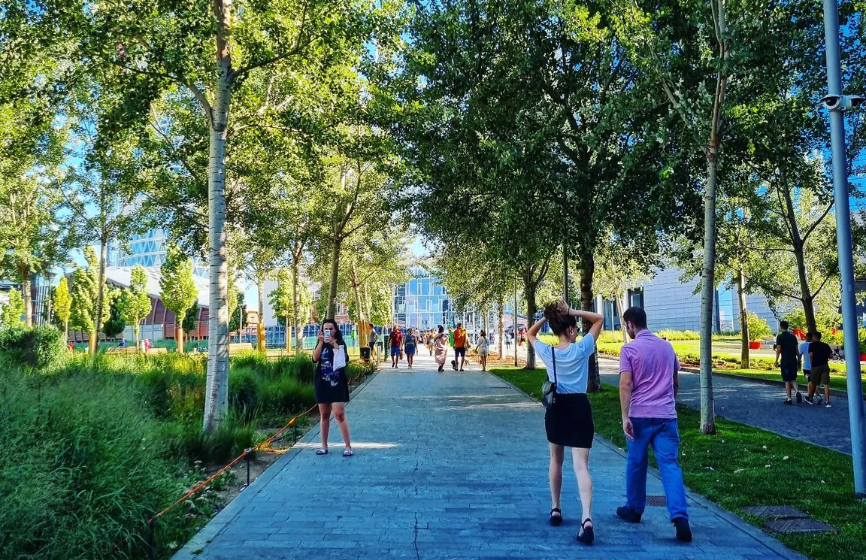Walking in Milano
From Corso Garibaldi to Corso Venezia

Milano is a city made for walking, and many areas of the city have been pedestrianized in recent years.
At a brisk pace, the city can be traversed from North to South (15 km) in a few hours, and the 90/91 ring around the city (19,5 km) in a little more than that.
Several urban trekking associations are active in the city, if you wish to join experienced walkers who are into city discovery, like the crime novelist Gianni Biondillo who has devoted a book to Milano’s urban trails and psycho-geography.
The first walk that YesMilano proposes is a journey from Corso Garibaldi to Porta Venezia.
Exit the metro station of Lanza (M2, green line) and you’ll see neo-modernist Piccolo Teatro Strehler, where European drama productions are staged, and Arnaldo Pomodoro’s bronze sculpture, the Spiral Tower.
Make a right after the ticket office to reach Corso Garibaldi (there also a theater, Teatro Fossati, with the effigy of the Great Liberator of Italy - Giseppe Garibaldi himself), a long and bustling thoroughfare colonized by walkers, thanks to the Slow Traffic Zone covering a very Milanese area that well expresses the style, culture and variety of the city’s inhabitants.
Check out Piazza San Simpliciano with its medieval church, an unexpected corner of beauty and tranquility.
Along two lines of curious shops and striking bars, Corso Garibaldi takes you to the Moscova metro station and Largo La Foppa.
There’s a handful of cool and young bars in the vicinity and this is one of the squares where the city’s movida and aperitivo culture is strong and active, lasting well into the night.
If you walk a bit further, you can admire the quirky twin façade of the Church of Santa Maria Incoronata, dating back to the Renaissance.
Now you see the Porta Nuova skyscrapers on the horizon.
To get there you have to go through Piazza XXV Aprile and walk under the arch of Porta Garibaldi: there’s great food shopping and a fine movie theater, but if you can resist these temptations, as well as Corso Como’s, filled with cocktail bars and boutiques, you can climb the stairs of Via Capelli and arrive the heart of New Milano, the skyscraper plaza of Gae Aulenti with its international flagship stores and a promenade heading to a new park designed for wellness, BAM – the Library of Trees, and a whole new neighborhood, alternative and bohemian Isola.
From Porta Nuova, you can also walk on water and descend the escalators to the Porta Garibaldi railway station and suburban metro hub.
Isola thrives under the shade of the Vertical Forest Tower aka Bosco Verticale, the new wonder of Milanese architecture with trees and plants at all floors of the buliding.
The neighborhood is mostly populated by young people and young couples, and has a density of craft workshops and social activism unmatched elsewhere in the city.
There’s also Casa della Memoria celebrating the memory of the Resistance (which is remembered every year in Milano on April 25 with a national demonstration), and especially the new covered market of Mercato Isola, with delicatessen food stalls and eateries into the night.
More generally, Isola is the place where there’s always people on the sidewalks and you can actually run into somebody by accident, because it’s a place of serendipity.
Spend the evening at a restaurant or jazz club in Via Borsieri, then hang out with the locals at Piazzale Archinto. The artisans’ ateliers are in Via Thaon de Revel.
From Mercato Isola to Mercato Centrale, the incredible foodie heaven inside Stazione Centrale, you need to walk along Via Pola.
Stay on the right: soon the huge complex of the Lombardy Region, with its tower and glass-covered piazza, opens before your eyes with green meandering cycle paths and open-air sculptures.
Keep walking, there’s the Pirelli skyscraper, symbol of Milano’s postwar economic miracle, and on the opposite site skateboarders rolling on marble before a huge Babylonian architecture, it’s a sign you’ve arrived in Piazza Duca d’Aosta and Stazione Centrale, whose left wing is devoted to eateries and restaurants distilling the best of Italian gastronomy.
Once you’re sated, take Via Vitruvio with its trams, kebas, cheap pensions, to reach the Via Benedetto Marcello Gardens that signal your entrance in Porta Venezia.
Milano’s rainbow neighborhood is located between the Palestro Gardens (which hosts the Natural History Museum and has rides for kids) and the end of Via Melzo, filled with bars and restaurants like perpendicular Via Spallanzani, on the other side of the Porta Venezia Gate.
It comprises some of the most beautiful Liberty architecture (Casa Galimberti), as well as buildings designed by Italian futurists.
The heart of the district is the maze of streets between the Lazzaretto and Via Vittorio Veneto, which are eminently walkable and dotted with Ethiopian, Tigrayan, Eritrean restaurants, complemented by Indian and Italian venues.
Around Via Lecco, there many LGBTQ bars, where Milano’s sizable gay, lesbian and transsexual community loves to congregate in the company of their friends.
The Milano Pride takes place here each year at the beginning of the summer, and the rainbow décor of the M1 P.ta Venezia metro station expresses the hood’s queer proudness.
For shopping, Corso Buenos Aires is one of the longest avenues devoted to shops and stores in Europe, starting in P.ta Venezia ending in P.le Loreto, at the intersection of the M1 and M2 metro lines, which will soon be completely renovated landscaped as a green shopping complex.

 Log in
Log in

